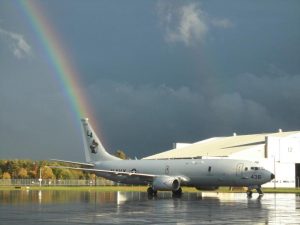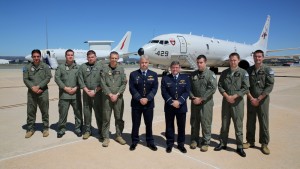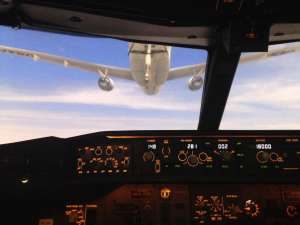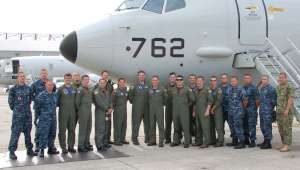2016-06-11 By Robbin Laird and Ed Timperlake
During our visit to Jacksonville Naval Air Station, we had a chance to talk with Lt. Alan Tucker, the VP-16 Squadron Maritime Tactics Instructor (SMTI).
He has surface fleet experience and came to the P-8 four years ago and started as a weapons school instructor in VP-30. VP-30 is the squadron where initial training for P-8 crews occurs.
Lt. Tucker explained that the shift from the P-3 to P-8 was not just about a new aircraft, but training to operate very differently and to engage with the fleet and the joint force very differently as well.
He started by explaining that the P-3 in its later years required significant maintenance and crews had to focus significant time to bet ready to fly and then to operate the aircraft, which reduced the training and time to do the mission.
“Most of our training and our focus in the squadron was safety.
Tactics and execution was done with whatever bandwidth you had left, because you were always fighting problems and always training for degraded mission status because every airplane was degraded in some form or the other.”
With the P-8, the new aircraft highlights the opportunity to refocus on tactics and training and doing so as the US Navy and the joint and coalition force is focused on shaping effective tactics to prevail in the emerging “Kill Webs” in a global extended battlespace.
“What we were able to do is refocus our emphasis.
Instead of training on safety and NATOPS being the center focus of attention, we’re now able to focus on the tactics.”
The shift in tactics facilitated by the technology aboard the plane and the connectivity of the aircraft allows the P-8 to operate as an inorganic asset for the Carrier Strike Group that can be seamlessly integrated organically into its operations as needed.
“We’re an inorganic asset to the CSG that can quickly meld right into what they’re doing. We can provide significantly enhanced situational awareness for the fleet as they operate.”
And even though the current generation of weapons is more limited than desirable, the P-8 is capable of integrating new weapons of much greater reach and range to support the fleet as well.
And with the off-boarding capability of the aircraft to provide sensor data to deployed shooters, the P-8 can significantly contribute to the strike capability of a deployed force.
Already, the P-8 is working with the USAF and is working ways to expand sharing of data and shaping an extended range common operating picture.

This clearly was not what the P-3 was designed to do; for it was operating “alone and unafraid” and doing its ASW mission within a particular sector.
With the P-8, the tactical envelope expands and it trains to operate as an organic asset, a connected asset, or a force multiplier for a distributed force, especially in synergistic partnership with the soon to be introduced Triton.
“We can cross-queue our airplane with another platform to triangulate, and/or send that information back to the intel shop, where you have folks sitting on the ground at zero knots.
They’ll get us an answer back for our immediate use on station.”
And the P-8 and its crew is working from the ground up with regard to a 21st century approach to prevail in the electronic or tron warfare maneuver space as well.
“We’re a key player in the kill web.
What do you need from us today?
What’s the task?
What do you want executed?
We can provide a wide variety of capabilities.”
The crew of the P-8 is shaping a new work culture with their combat crews to support the evolving tactics in support of flexible missions.
Rather than operating in separate cells on the aircraft, the crew seamlessly interacts from their screens and communications suites with each other with reach back to onshore or afloat assets.
“With the rail setup (the combat crew is lined up at a linear rails with interchangeable screens) we can access each other’s systems. We can load-share more effectively.
We are doing 21st century team building.
You have so much data coming onto the airplane that you have to now manage everything that’s coming in.
It requires all your operators to work together, filter out key pieces that you need to do your primary duty, and then with whatever bandwidth you have left, you can assist another operator to work the information.”
A key work shift is learning to manage the transition as well of information from one P-8 to another as the planes take off and land.
Because one is sortieing information not just airplanes, a key task is to manage the data transfer and mission management function as well.
As Lt. Tucker described it, each deployment was providing enhanced experience for shaping more effective tactics.
The first deployment simply required familiarization but with the second the squadron was pushing the boundaries of the aircraft and shaping new tactics.
“It is about continued combat learning and learning how to use the aircraft in a different way.

It is about opening up the envelope and shaping the combat capability of the aircraft, and shaping more effective tactics going forward.”
You learn as you deploy; you rewrite software code to build on those experiences.
It is about combat learning and shaping new ways to operate and prevail in combat with the maritime, joint and combined force.
And with projected weapons upgrades, the P-8 will become not only a state-of-the-art sub killer but a very sensor empowered standoff air/land strike platform.
With allies flying the P-8 as well there is the opportunity to expand situational awareness within the battlespace as well.
“We already integrate with Growler and the E2.
And with allies such as the RAF, the Australians and the Indians, we can shape a broader situational awareness picture as well.”
Lt. Tucker flew on the around the world flight of the squadron as well, the P-8 equivalent of the Great White Fleet, but done in the digital age.
Their P-8A Poseidon logged a total of 22,000 miles.
And while in Australia flew the Wedgetail simulator to learn how the Aussies were refueling their military 737, the Wedgetail.
According to an article by Lt. Christian Suszan, MPRWS EP-3E Weapons and Tactics Instructor published on August 12, 2015:
On July 6, aircraft 762 launched from Cecil Airport in Jacksonville, to travel around the world, making stops in Germany, Bahrain, and Australia, in order to increase P-8A Poseidon mission effectiveness for future global employment.
On board the Poseidon were 11 VP-30 and VP-5 maintenance personnel and 10 aircrew from VP-30, Maritime Patrol and Reconnaissance Weapons School (MPRWS), and VP-5.
Also on board were VP-30 Commanding Officer Capt. Curt Phillips, Officer in Charge of the P-8A Fleet Integration Team Cmdr. Andy Miller, and MPRWS Executive Officer Cmdr. Michael Puffer.
The primary intent of the mission was to prepare VP-5 “Mad Foxes” and 5th Fleet staff for the first P-8A deployment to the Middle East area of responsibility.
Another intent was to meet with the Royal Australian Air Force (RAAF) ahead of fleet implementation of the P-8A’s air-to-air refueling (AAR) capability.
The RAAF currently possesses and employs the in-flight refueling capability on its Boeing 737-700 based E-7A Wedgetail Command and Control aircraft.

While enroute to Bahrain and Australia, the crew made an overnight stop at German Naval Airbase Nordholz, to attend German Maritime Patrol Symposium events and provide a static display for symposium attendees.
Among those attending the symposium was NATO’s Commander, Maritime Air and Deputy Chief of Staff, Maritime Air for NATO Allied Maritime Command (MARCOM), Rear Adm. Thomas Ernst, German Navy, as well as maritime patrol aircrew from Canada, Norway, Spain and Germany.
While in Bahrain, the P-8A crew provided a static display for the U.S. Ambassador to the Kingdom of Bahrain, the Honorable William Roebuck, as well as executed a local demonstration flight with top Bahraini military officials on board.
The P-8A crew briefed Commander Task Force 57 on current and future capabilities, as well as limitations, and held meetings to discuss the roadmap ahead of VP-5’s deployment.
The crew conducted a local demonstration mission flight with 5th Fleet personnel to showcase P-8A capabilities and identify any potential issues well ahead of VP-5’s deployment.
“Our role as the Fleet Replacement Squadron is to help prepare VP-5 for its deployment to the region,” said Phillips.
“This trip tests the P-8A platform within the environment of the 5th Fleet area of operations and provides us the opportunity to get hands-on experience so we can get VP-5 tactically prepared for a slightly different mission set compared to the mission in the Western Pacific.”

The crew then visited RAAF Base Williamtown, headquarters to Australia’s Air Combat Group, located approximately nine miles north of the coastal city Newcastle, New South Wales.
The P-8A aircrew held a static display for local aircrew and support personnel stationed at the base. During the visit, RAAF personnel provided briefings on E-7A operational employment and AAR best practices to better equip VP-30 as they implement their AAR training program in the near future.
The P-8A FRS and MPRWS crews were afforded the opportunity to fly an E-7A Wedgetail AAR simulator event to experience first-hand an AAR evolution.
Intermediate stops for fueling and crew rest during the around-the-world mission included Perth, Naval Support Facility Diego Garcia, Pago Pago, and Hickam AFB, Hawaii. Aircraft 762 and its crew arrived back at Cecil Airport on July 18.
“From Europe to the Pacific, this flight is about maintaining our critical, long-standing maritime patrol partnerships, while sustaining the momentum of P-8A Poseidon training and operational transition of the Fleet,” Phillips stated.
“VP-30 and the weapons school are charged to prepare P-8A Fleet squadrons ahead of future deployments and capabilities – 5th Fleet’s hot weather environment and forthcoming air-to-air refueling operations are just the next chapter in P-8A transition. We will be prepared.”

